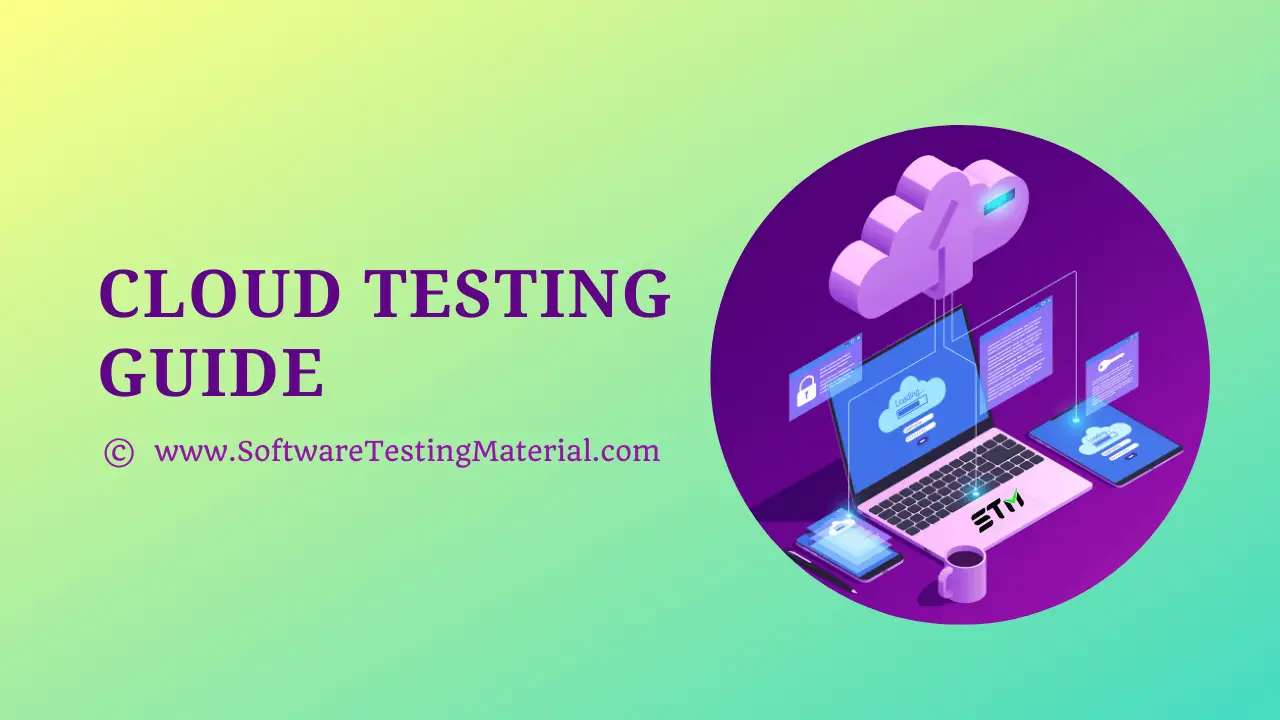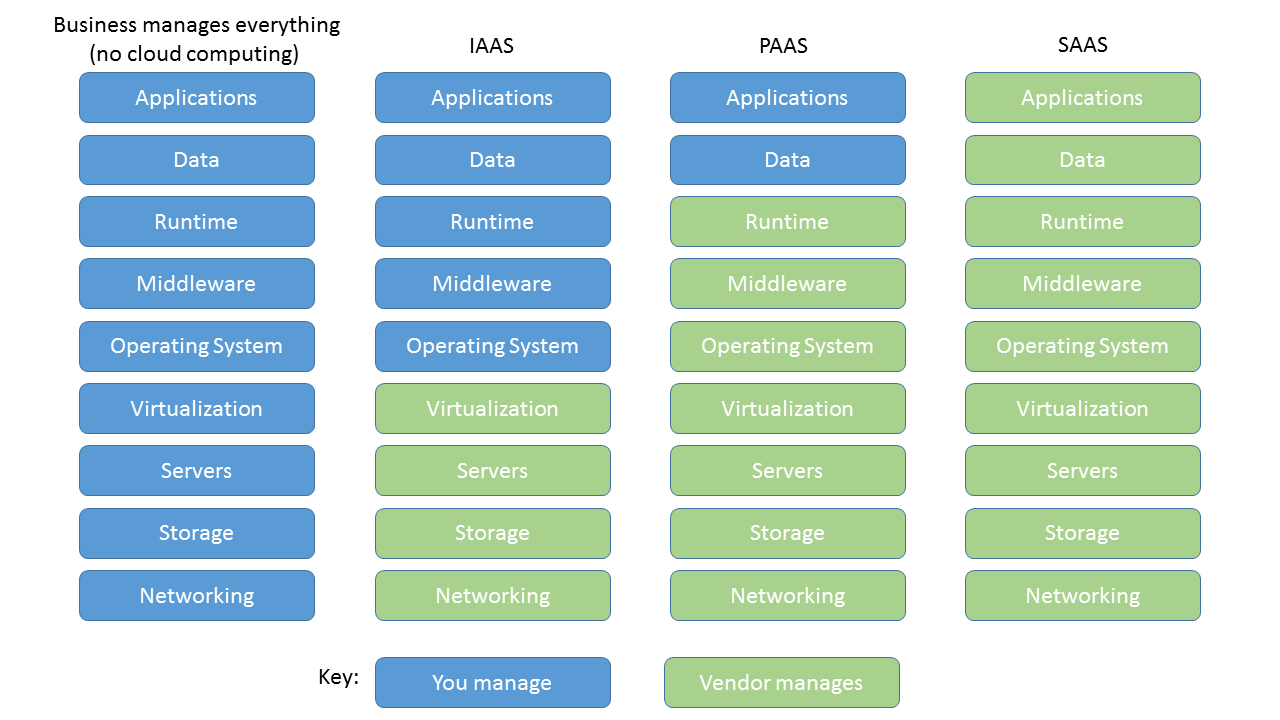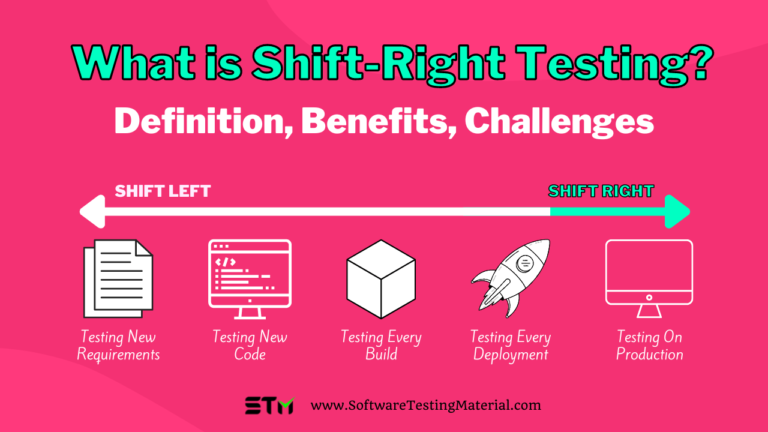Cloud Testing – A Detailed Guide

In this Cloud Testing guide, we will learn the following.
Before understanding, Cloud Testing lets understand what is Cloud Computing.
What is Cloud Computing?
Cloud computing is the on-demand delivery of computing services such as servers, data storage, databases, networking, software, etc., typically over the internet and on a pay-as-you-go basis.
These services and storage are offered by various Cloud providers. To Utilize these services, Company pays to cloud providers which are very cost-effective, because if the company goes for in-house server storage, databases, application, and services, it will cost the company a huge amount.
Let’s take an example, a mid-scale organization wants to expand its businesses through an online portal of its products and services.
For their online portal, they need server space, databases, etc., They have to invest a lot on this.
They could have adopted an In-premises software development model if cloud computing wouldn’t have come into the picture.
Due to cloud computing, it’s very easy to hire or take a rented space or storage on a server, services, databases, networking, or anything which you get from your personal computer or from your owned server.
Hope you understand what cloud computing is. Let’s see who are all the top cloud providers in the market.
Following are the top cloud provider list
- Amazon web services
- Microsoft Cloud
- Google Cloud Platform
- IBM cloud
- VMWare
- Alibaba Cloud
Cloud Computing models
Cloud computer providers follow 2 types of models
- Cloud Computing Service models
- Cloud Computing Deployment models
Just like a normal software development models, there are several cloud computing service models. Cloud providers adopt these models and provide the services to different organizations to fulfill their computing needs remotely.
The following are the models.

The below image shows the difference between IaaS (Infrastructure as a service), PaaS (Platform as a service), and SaaS (Software as a service) with comparison to personal computing.

Public Cloud: This cloud is available to individuals and organizations in a Public environment
Private Cloud: This cloud is only available to a single organization.
Hybrid Cloud: This cloud is a mix or hybrid of 2 or more clouds(Private, Public, or Community).
Community Cloud: This cloud is shared by specific organizations to help some community’s specific concerns.
What is Cloud Testing?
Cloud testing is also known as Cloud-based testing.
Cloud testing is a subset of Software testing which uses cloud-based tools to emulate real-world web traffic to test cloud-based web applications.
It verifies and validates web application performance, reliability, scalability, interoperability, disaster recovery, and security.
Nowadays most of the applications are developing using cloud environments. We have to have a good cloud testing strategy to test cloud-based applications.
What is Tested in Cloud Environment?
While doing In-premises testing, software testing is done on the inhouse server, software, and hardware.
Whereas in a cloud environment, software testing is done on the cloud or on a virtual environment which is provided by cloud providers.
The following are the testing types which is performed mainly on the cloud environment

1. Functional testing: Functional flow of the application is tested on the cloud to verify that business needs are met and each major and minor functional aspect of the application is giving the expected output.
2. Browser compatibility: To verify the application works on multiple browsers and browser versions on the cloud environment.
3. OS Compatibility Testing: Application is tested on various Operating systems like Windows, Linux, Mac, Android, IOs, and Windows.
4. Load and performance testing: Load testing becomes very important in the cloud environment to check how the application performs when it deals with expected numbers of users, and to check the response time and to identify the bottlenecks.
5. Stress and Volume testing: Testing is done under heavy loads, with huge data, to identify how the application performs when there are more than expected users. In cases of an application crash, proper action can be taken.
6. Security Testing: To check the cloud application is secure, testers do authorization and authentication testing, API testing, database testing, network access testing, compliance testing, etc.,
Following are the steps of testing on the cloud environment

We can see many cloud-based testing tools in the market due to the growing popularity of cloud testing.
Here are some of the hugely popular cloud-based software testing tools.
Cloud-based Testing Tools
The following are the few tools that are widely used.
- SOASTA CloudTest
- LoadStorm
- BlazeMeter
- Nessus
- App Thwack
- Jenkins Dev@Cloud
- Xamarin test cloud
- JMeter
- AppPerfect
These are the tools that are used to test the web or mobile application performance and functional testing as well. Most of these tools provide record and playback feature to record performance testing scenarios and also highlight the performance bottlenecks in the reports.
There are some security testing tools also
- Wireshark
- Nessus
- Nmap
Challenges in Cloud Environment
Security challenges: Companies are hosting their data on the cloud environment. The cloud environment is owned by a third party. This is the biggest concern of companies because it may lead to a leak of confidential data, virus attacks, and the stealing of application logic. It may happen because cloud vendors may not aware of Industry standards of security.
Challenge with dealing with different cloud models: Due to competitive technologies and demands, nowadays organizations are adopting multiple cloud models with different vendors. It becomes challenging to maintain security, synchronization, speed, application availability, and scalability because now software is not hosted on a single cloud.
Lack of Expertise in Cloud testing tools: Although cloud computing has gained so much popularity and growing like a giant, but still skill full resources or experts are hard to find. Due to this, it becomes challenging to utilize cloud testing tools.
Budget challenges: Some time organizations are not aware of hidden cost or not able to predict the usage of cloud environment and services until cloud vendors come up with surprising cost elements which can disturb the overall budget of the business. This becomes very challenging for the organizations which are entering into cloud computing as newbies.
Challenges related to compliances: Every Cloud vendor tries to give better and improved services to their clients as compared to their competitors. To provide better security and accuracy of their computing environment they opt for governing compliances, and if any organization is using their cloud then the organization also has to follow these governing compliances. This becomes a challenge sometimes for some organizations.
Issues related to Performance: Due to server downtime, a lot of businesses lose the profit, and the main issue is organizations can’t do anything to improve until they change the cloud vendor. This issue has caused many businesses a big failure, and it is really a big challenge for organizations whose business is completely on the Internet.
Skills required to be a Cloud tester
To be a cloud tester some foundation testing skills are required as well as some cloud computing-related skills are also required. The following are the skills
Basic skills
- Testing fundamentals
- Test management – test cases, bug report, bug life cycle
- Functional testing
- Operating systems & Cross-browser compatibility testing
Cloud computing skills
- DevOps and Agile Methodologies.
- Automation tools for cloud environment
- Performance testing
- Security testing
- Availability testing
- Disaster recovery testing
- Scalability testing
Benefits of Cloud Testing
Availability
Nowadays teams are located in different locations across the world and due to cloud-based computing its very easy for the testing team and the entire team to access the application from any location. It’s available 24/7.
Cost-effective Automation Testing
When any company goes for cloud-based computing, it gets tools and environment at a much cheaper price than the company’s licensed tools. In traditional testing, the company has to buy the tool or buy the license for each user. Whereas in a cloud-based environment they need to pay when the ‘tool is utilized‘.
Teamwork
Any tester from any corner of the world can test the application at any time and the team’s work will be in sync and results are achieved in a faster way. As a result, it helps the management to deliver the project on the time with speedy execution.
Tools and IT Services are easy to use
In a cloud-based environment, the testing team does not need to worry about installation or setup issues. All these services are given by cloud vendors and everything is included in their services. Testers have to raise the ticket or query to install the required tool, and the request will be completed within a fair amount of time.
Collaboration with the Development team is easy
Due to continuous integration, it is very easy to collaborate with the development team.
Test team tests the application immediately once the development team deploys the code. Redeployment and retesting are done without any delay once testers raise any issues.
Due to faster execution, every phase goes very smoothly and overall production release becomes faster.
Quality is achieved
Due to faster execution, and deployment testing team gets additional time to test hidden scenarios, and go for multiple rounds of regression testing leads to better test coverage. They can find more realistic scenarios and do end to end testing due to sufficient time. Due to this overall quality of the application is achieved
Multiple environment testing
Due to cloud-based computing, it is possible to test the application on various operating systems, various browsers, various hardware devices, and different networking bandwidth. It’s very easy for the testing team to identify the real-world performance testing scenarios. They can perform load testing, volume testing, and stress testing by adding up thousands of virtual users.
Supports Agile Development
A cloud-based environment supports agile development, where the entire team (dev and test team) is involved throughout the development process. A cloud-based environment provides the luxury to utilize all agile practices and their benefits.
Cloud testing vs Traditional testing
| Cloud Testing | Traditional Testing |
|---|---|
| Supports agile methodology as continues integration is very easy in cloud computing. | Agile is supported but continues integration is completely dependent on environment availability, and team collaboration. |
| Automation is easy and installation of tools is very fast, its done by IT service desk provided by cloud vendors. | Automation depends on tool availability and installation setup which is done by testing team itself. |
| Security testing is very important and skills of a test engineer plays an important role when application’s important data is present on cloud there are chances of data leakage or hacking. | In premises or Traditional testing where application is typically deployed on own’d server, security is not a major concern. |
| Performance testing is easy tools are available and generating real world testing scenario is possible on cloud. | Performance testing is done using any tool and licence is required to generate no of virtual users. |
| Compatibility testing using different machines, operating systems, Browsers or different mobile simulators is easy. | Compatibility testing is limited to resources available, and generally this type of testing is skipped if not asked by client specifically. |
| Cloud testing is considered a full coverage of functional and non functional testing scenarios with ease, more scalable and with rapid results. It goes with in depth testing where real world scenarios are captured and tested. | In-premises testing is more focused on Functional testing and non-functional testing is only done when it is explicitly mentioned by client, or generally overlooked, Or only higher level of testing scenarios are considered. |
| Cloud environment testing is a cost effective because it uses ‘pay per use’ model. | In-premises testing is costly because for every tool company has to go for licence, and some time tool is not completely utilized. |
How to do cloud testing
Just like traditional testing, test cases and test scenarios are developed for cloud testing.

Following are the testing steps which are performed
1. Test planning and Test scenarios are prepared
High-level user scenarios are created with the business objective.
2. Design Test cases
Test cases are prepared on the basis of user scenarios which specify the steps and expected results.
3. Select Cloud Service Provider
As per the need and feasibility, a cloud service provider is selected.
4. Setup Infrastructure
Team setups all the testing environment and infrastructure for testing.
5. Leverage Cloud Servers
Virtual users are created, and all the services are utilized which is provided by cloud vendors.
6. Start testing
Testing is done on the application, all kinds of test cases are performed like Functional, Performance, Security. Issues are logged, fixed, and retested.
7. Monitor Testing Goals
Multiple rounds of testing are done, monitoring is done and if testing goals are achieved then testing is stopped.
8. Deliver Results
Deliver test results and signoff cloud testing.
Types of Cloud Testing
Overall cloud testing carried out by following testing types.
- Application-specific testing (functional and non-functional)
- Network testing (Speed and bandwidth testing)
- Recovery testing (Disaster recovery, backup, storage, and infrastructure compliance testing)
The following are some other testing types that are very important in the cloud environment.
Availability
- The application should be available to all end users for the planned period of time
Security
- Authorization and Authentication testing
- Confidentiality
- Integrity
- Nonrepudiation
Performance & Scalability testing
- Testing under normal user load
- Testing under heavy user load
- Volume testing
- Stress testing
- Check application performance when resources are getting scale up or scaling down, resources can be CPU, Hard drives, Network protocols, database servers, etc.
Cloud Compliance testing
- Cloud compliance means rules and regulations which every cloud vendor has to comply with. For example, the health care industry, a set of Rule ‘HIPAA’ has to be followed, it has strict guidelines and security protocols that every cloud vendor has to follow for the health care industry. In the same way, the different industry has different security protocols to follow which should be obeyed by cloud vendors and present in their compliance documents.
Multi-tenancy testing
- Multi-tenancy is the important feature of cloud-based computing which means on a cloud environment multiple clients are using the single resources without knowing each other, and their data is kept separate from each other. Here data security testing is a must to check only relevant data or authorized user is able to access the data, and data is fully secured if multiple tenants are utilizing the resources.
In Conclusion
In today’s scenario, cloud computing is in high demand because of various benefits it provides like scalability, flexibility, and cost-effectiveness. Still, this technology is new and underutilized by some organizations because of challenges associated with this.
Still, organizations are learning and moving towards the cloud computing environment, and this is the future. As a Test engineer, it is a great path of learning new things and earn equally like developers.
Related Posts:






